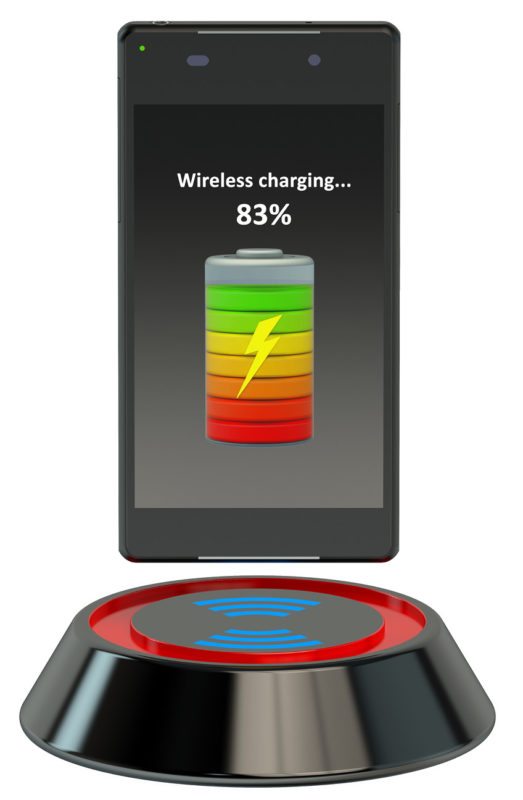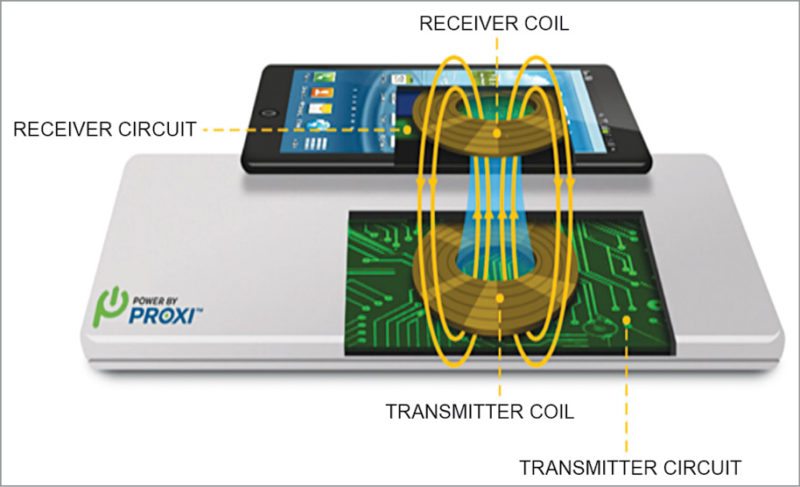Nikola Tesla in the late-18th and early-19th centuries described a device that he believed could transmit electrical power from one conductor to another without the need for wires. But his work in this field failed due to engineering and financial limitations. Soon thereafter power cables became the commonly-accepted means of transporting electricity across distances. But with widespread adoption of small, portable devices with batteries in need of constant recharging, people’s attention is again turning to wireless power. Let us read more about wireless charging technology
Types of wireless charging
Power through radio waves. Transmitting power through radio waves at first seemed promising. A good example of how radio waves can transmit power is a crystal radio. This basic radio consists of a long wire as an antenna, a diode, another wire to act as ground wire and a crystal earphone. By attaching the two wires to either end of the diode, connecting the ground wire to a metal stake in the ground and connecting the crystal earphone to the ends of the diode, this radio can pick up radio waves that we can actually hear. We do not need a battery or any other power source to hear these; radio waves themselves provide the power.
The trouble with radio wave transmissions is that these are not very efficient. These spread out as these transmit; only a relatively-small percentage would make it to the antenna for the charging device.
But there are other methods to send electricity wirelessly, including through microwaves or magnetism. Magnet approach really resonated with engineers looking for a way to get rid of those extra charging cords.
Resonant wireless charging
There are mainly two types of wireless charging: inductive and conductive. Inductive charging involves an electromagnetic field to transfer charge across a gap and into the device’s battery. Requisite for inductive charging is an induction coil, which is capable of receiving wireless energy. Conductive charging functions through direct electrical contact between the power source and the battery.
Wireless charging or inductive charging uses an electromagnetic field to transfer energy between two objects. This is usually done with a charging station. Energy is sent through an inductive coupling to an electrical device, which can then use that energy to charge batteries or run the device.
 Induction chargers typically use an induction coil to create an alternating electromagnetic field within a charging base station. A second induction coil in the portable device takes power from the electromagnetic field and converts it back into electric current to charge the battery. The two coils will form an electrical transformer, when placed in proximity.
Induction chargers typically use an induction coil to create an alternating electromagnetic field within a charging base station. A second induction coil in the portable device takes power from the electromagnetic field and converts it back into electric current to charge the battery. The two coils will form an electrical transformer, when placed in proximity.
Greater distances between sender and receiver coils can be achieved when the inductive charging system uses resonant inductive coupling. Recent improvements to the resonant system include using a movable transmission coil, for example, mounted on an elevated platform or arm, and the use of silver-plated copper or sometimes aluminium for the receiver coil to minimize weight and decrease resistance due to skin effect.
Through this process, power can be transferred safely over an air gap and also through any non-metallic object that might exist between the coils, such as wood, plastic or granite.
Adding extra coils
Addition of extra (or larger) transmitter coils can also extend the range at which power can be transferred. Wireless charging is based on the principle of magnetic resonance or inductive power transfer, the process whereby electricity is transferred between two objects through coils using the following key steps:
1. Mains voltage is converted into high-frequency AC.
2. The AC is sent to the transmitter coil by the transmitter circuit. It then induces a time-varying magnetic field in the transmitter coil.
3. The AC flowing within the transmitter coil induces a magnetic field that extends to the receiver coil (when within a specified distance).
4. The magnetic field generates current within the receiver coil of the device. The process whereby energy is transmitted between the transmitter and the receiver coil is also referred to as magnetic or resonant coupling, and is achieved by both the coils resonating at the same frequency.
5. The AC current flowing within the receiver coil is converted into DC by the receiver circuit, which can then be used to charge the battery.
Wireless charging technology
2D charging solution Current options for wireless charging of smartphones and tablets involve the use of a charging pad that acts as the transmitter, transferring power to a miniaturised wireless receiver integrated into smartphones or tablets. This is the safest and most-efficient wireless charging pad technology for electronic devices like smartphones, phablets and tablets, enabling simultaneous wireless charging of multiple devices, with full spatial freedom for placement of devices in any position (no exact alignment).

Miniaturized receivers are integrated directly into the devices, removing the need for external housing covers or sleeves on devices. With continued advances in wireless charging technology, transmitters built into workstations, desks, tables and a whole range of everyday furniture will soon become a reality.
Wireless charging for wearables and devices using AA batteries. In order to truly deliver wireless charging for all consumer electronic devices, technology needed to somehow enable charging of irregular shaped objects, that is, not only thin form or flat in shape. Such devices commonly use AA batteries or specialised small batteries in the case of wearable devices. This is called in-device charging and it means convenient, simultaneous charging of multiple devices including remote controllers, gaming devices, cameras, toys, wearable devices and more, without having to remove and replace batteries.
Wireless ambient power
Companies are developing a technology that could draw enough power from ambient radio waves to keep a mobile phone handset topped up. Ambient electromagnetic radiation—emitted from Wi-Fi transmitters, mobile phone antennae, TV masts and other sources—could be converted into enough electrical current to keep a battery topped up. They are working towards a prototype that could harvest up to 50 milliwatts of power—enough to slowly recharge a phone that is switched off. Current prototypes can harvest three to five milliwatts.
Wirelessly powered light bulb
Researchers have created a revolutionary device that could remotely charge batteries and power household appliances. They have shown that it is possible to wirelessly power a 60-watt lightbulb sitting about two metres away from a power source. They have demonstrated, for the first time, that it is feasible to efficiently send that much power over such distance. The experiment paves the way for wirelessly charging batteries in laptops, mobile phones and music players, as well as disposing of electric cords on household appliances.
Benefits
Whatever the application, removal of the physical connection delivers a number of benefits over traditional cable connections, some of which are not always obvious. This article highlights below some of the benefits and advantages of resonant wireless charging and offers an insight into a world where wireless power is widely integrated into the home, office and everyday lives:
1. From an environmental standpoint, wireless charging could be incredibly promising. It would eliminate the need for plastic-body chargers, which not only drain power but are also replaced regularly. Wireless charging could save tens of thousands of tons of chargers from ending up in landfills and allow users to tap into existing electronic activity instead of traditional power sources.
2. It provides greater convenience and ubiquity for charging of everyday devices.
3. It would reduce costs associated with maintaining mechanical connectors.
4. It would allow safe powering or charging of devices that need to remain sterile or hermetically-sealed (waterproof).
5. It would prevent corrosion due to elements such as oxygen and water.
6. It would eliminate sparks and debris associated with wired contacts.
7. It would provide protected connections; no corrosion when electronics are all enclosed, away from water or oxygen in the atmosphere.
8. It is safer for medical implants (embedded medical devices). It allows recharging/powering through skin rather than having wires penetrate the skin, which increases the risk of infection.
9. It is durable. Without the need to constantly plug and unplug devices, there is significantly less wear and tear on the sockets of the devices and the attaching cables.
10. It enables non-radiative energy transfer.
11. It can be more convenient as there is no need for cables.
Disadvantages
Some disadvantages of wireless charging are:
Lower efficiency and waste heat. Main disadvantages of inductive charging are its lower efficiency and increased resistive heating in comparison to direct contact. Implementations using lower frequencies or older drive technologies charge more slowly and generate heat within most portable electronics. It is not as efficient as a direct cable connection. Wireless charging is around 60 per cent to 70 per cent efficient, and it is still recommend that booting a device from cold is done through a wired connection.
Slower charging. Due to lower efficiency, devices can take longer to charge when supplied similar power.
More expensive. Inductive charging also requires drive electronics and coils in both device and charger, increasing complexity and cost of manufacturing.
Short-distance applications. Whether or not it incorporates resonance, induction generally sends power over relatively short distances.
Solutions
Given below are some possible solutions:
1. Newer approaches reduce transfer losses through the use of ultra-thin coils, higher frequencies and optimised drive electronics. This results is more efficient and compact chargers and receivers, facilitating their integration into mobile devices or batteries with minimal changes required. These technologies provide charging times comparable to wired approaches, and these are rapidly finding their way into mobile devices.
2. For day-to-day use, just lining up the coils and letting electromagnetism do the rest is the simple value proposition at the heart of wireless charging. It is worth noting that the lithium-ion chemistry used in smartphone batteries happily copes with having short bursts of energy to charge these up. This is exactly what wireless charging can provide.
3. Future plans for wireless power involve moving electricity over a span of kilometres. A few proposals even involve sending power to the Earth from space. The secret was a large, ground based microwave transmitter. A large, disk-shaped rectifying antenna, or rectenna, changed the microwave energy from the transmitter into DC electricity. This was because the microwaves’ interaction with the rectenna had a constant power supply as long as it was in the range of a functioning microwave array.
Rectifying antennae are central to many wireless power-transmission theories. These are usually made of an array of dipole antennae, which have positive and negative poles. These antennae connect to semiconductor diodes. These collect microwave energy and transmit it to the diodes. It will act like switches that are open or closed as well as turnstiles that let electrons flow in only one direction. These direct the electrons to the antenna’s circuitry. The circuitry routes the electrons to the parts and systems that need these.
Safety concerns
There will be safety issues, real or imagined, as all power has to pass through space in some form or the other, and pass through any bodies lying in its path. However, researchers have minimized this problem by ensuring that power is mainly in the form of a magnetic field. It is a form of energy to which the body is almost entirely insensitive. It is believed that wireless charging is safe, even for people with implanted medical devices such as pacemakers.
Although researchers have not made a detailed study to test how the system interferes with pacemakers, however, they do not expect it to interact strongly with objects that do not resonate at the same frequencies that are used to transfer power.
You may also like Charging Batteries Wirelessly in a Compact, Efficient Manner
Dr S.S. Verma is a professor at Department of Physics, Sant Longowal Institute of Engineering and Technology, Sangrur, Punjab






